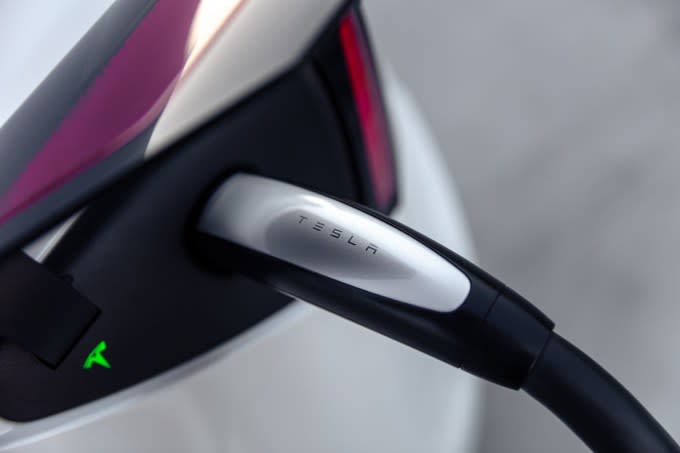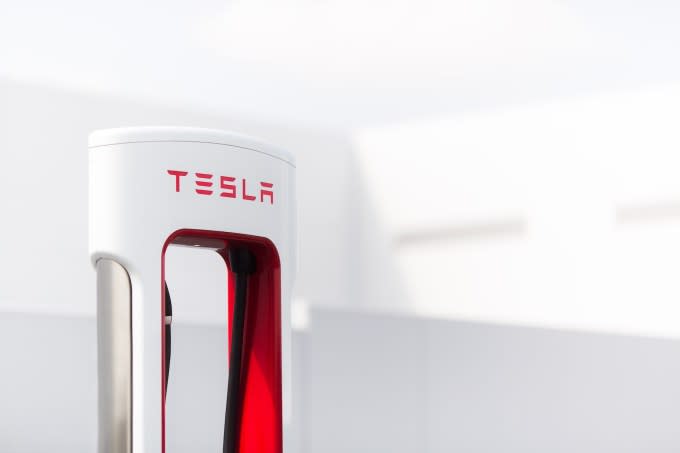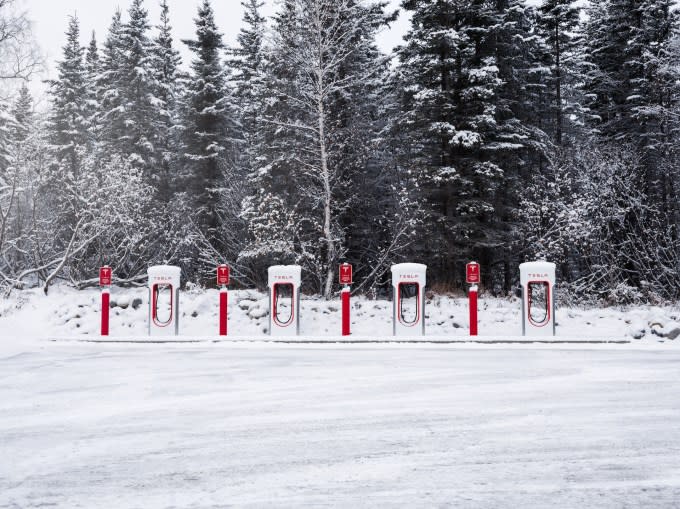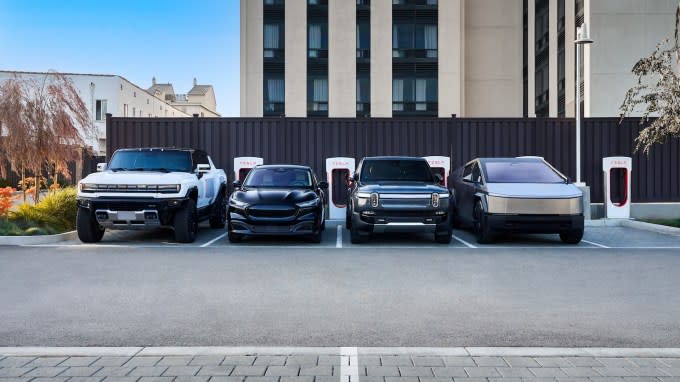Tesla’s profitable Supercharger network is in limbo after Musk axed the entire team
- Oops!Something went wrong.Please try again later.
At the start of the year, Tesla’s Supercharger team was tasked with the impossible. “We were on an exponential path,” a former team member told TechCrunch, adding that the new targets were “super-duper crazy.” Despite the bottlenecks that such expectations can create, “every time they upped the metric, we met it.”
Then, one day in April, CEO Elon Musk axed the entire division, even though it was profitable last year.
With more than 25,000 charging ports in the U.S. and over 50,000 worldwide, the Supercharger network is the undisputed king of EV fast charging. Widespread, well-maintained and fast, the network has transformed the way people viewed EVs, assuaging concerns about range anxiety for wide swaths of the car-buying public. But with the recent layoffs, Musk cast a cloud over the private infrastructure project.
While some people expected layoffs to hit the Supercharger division, few thought it would be eliminated.
“We built the best network in the world,” according to the former Tesla employee who spoke to TechCrunch. “We were minding the ship. Nothing was frivolous.”
It wasn’t enough to save the team. Hundreds of people who were responsible for the construction of a linchpin for the company were suddenly gone. That wipeout has industry watchers, shareholders and former Tesla employees wondering how it will affect EV owners and the company.
The automaker has hit a rough patch lately, with sales not growing at their usual breakneck pace. Price cuts aimed at boosting sales have affected profits, which were down 55% in the first quarter from the same year-ago period. With Tesla getting squeezed, Musk made cuts — not with a scalpel, but with a chainsaw.
Tesla started cutting staff, and the first round of layoffs wasn’t the last. The Supercharger division, around 500 people strong, were let go in a second wave that broke at the end of April.
On Friday, Musk said that Tesla will spend $500 million on expanding and upgrading the Supercharger network. But as insider knowledge shows, it will be hard to hit that target without a team to oversee the work.
Before the layoffs, the Supercharger network appeared poised to extend its lead over competitors.

One source explained that Tesla had refined production and installation of Superchargers to the point where each post could cost as little as $20,000 to install, less than half the nearest competitor. A significantly more powerful version 4 of the Supercharger hardware, once poised for a broader rollout, now appears stalled.
At the time of the layoffs, dozens of Supercharger sites were in various stages of planning and construction, according to insider information shared with TechCrunch. Some sites that were almost ready to be opened are either in limbo or may not be opened at all, the source said.
Tesla was previously in a strong position to win awards through the federally funded National Electric Vehicle Infrastructure (NEVI) program, which has $5 billion to disburse to build a robust nationwide network of fast chargers.
The company had also been focusing its expansion plans on places with high demand, they added. Where the federal government was interested in improving coverage on a certain route and demand hadn’t yet materialized, Tesla’s policy team would prioritize winning NEVI funding for the site, according to the source.
“Everything was purposeful. Everything had a target,” one source told TechCrunch..
Often that meant building Superchargers at new sites, which are more straightforward to develop. Expanding existing ones is incredibly challenging, the source said, because leases often need to be renegotiated, utility upgrades coordinated and existing infrastructure worked around, all while continuing to serve existing customers. “Your cost per stall is exponentially higher than a fresh site.”
Analysts have long speculated that the Supercharger network could easily become a profit center, much like Amazon did when it opened its cloud services to other companies. But there, Tesla had Amazon beat: The Supercharger team was told that the network was profitable, the source said, even before other automakers gained access.
How the Supercharger network came to be

Tesla opened the first Supercharger station in September 2012 as the first examples of the Model S prowled the streets. Early models could deliver 100 kW, which was a big number at the time: CHAdeMO, a competing standard used by the Nissan Leaf, maxed out at 62.5 kW at the time, and the Combined Charging System (CCS) was still in the prototype phase.
The first stations opened in California, and soon more started sprouting up along highways on the East Coast, then the Midwest and Texas. Within a year, the company upgraded the equipment, bumping maximum power to 120 kW. And within three years, Tesla had a network that spanned the U.S., making coast-to-coast electric travel possible. As the company entered Europe, China and other countries, it added Superchargers there, too. Today, the network supports nearly 60,000 charging stalls on four continents.
Why the Supercharger network is considered the best

In the early years, Tesla Model S and X owners enjoyed unlimited charging at the stations — an incentive aimed at winning over new customers. When the Model 3 rolled out, the company started billing new owners for charging sessions, though the process was far easier than what competitors offered. Drivers simply had to plug the car in, and Tesla would bill a credit card on file.
Today’s Supercharger posts support up to 250 kW charging speeds. Other networks top out at 350 kW, but they aren’t nearly as reliable. Tesla says its network’s uptime is 99.95%, far better than its competitors. Real-world usage suggests that’s not far from the truth: A University of California–Berkeley survey of EV drivers in the San Francisco Bay Area found that while 25% of non-Tesla drivers experienced major problems with public chargers, only 4% of Tesla drivers did at Superchargers.
Can other EVs use Superchargers?

For over a decade, Superchargers were available only to Tesla owners. Because charge sessions had to be initiated by a handshake between the vehicle and the charger, and because billing happened behind the scenes, Tesla had tight control over who could use them. The company’s proprietary plug design didn’t hurt, either.
That started to change in the fall of 2022, when the company made the details of its plug design available to other automakers. (By that point, Tesla was already using the same communications protocol as CCS when charging.) Then, in May 2023, Ford announced that it would adopt Tesla’s plug design, known as the North American Charging Standard, and that its customers would gain access to 12,000 Superchargers across the U.S. and Canada. Soon, the floodgates opened, and GM, Rivian, Volvo and others followed suit. Today, all major automakers selling in the U.S. have adopted the NACS.
These are all the major brands that have announced adoption of the NACS for future EVs:
In February, Tesla started granting automakers access. Ford was the first to gain entry, and the company started offering existing EV owners free adapters for a limited time.
What’s next for the Supercharger network?
No one really knows. With future Supercharger sites in limbo, it’s possible that the network has reached its zenith, at least for the time being. Musk has said that expansion at new sites will continue “at a slower pace” and the focus will be on “100% uptime and expansion of existing locations.” Without a team in place, all of that will be challenging, especially work on existing locations, which are more complex endeavors.

